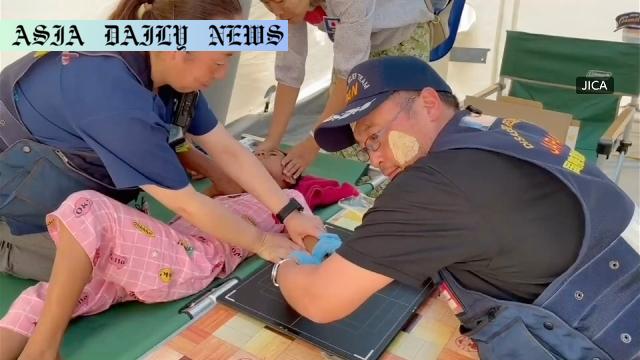Myanmar Earthquake: UNICEF estimates that 6.3 million people in Myanmar urgently need assistance and protection weeks after the earthquake.
- Myanmar Earthquake has left 6.3 million people in urgent need.
- Children and women face extreme health risks due to heat and scarcity of water.
- Malnutrition remains critical for young children and expectant mothers.
- Over 3,700 people have died, with 120 still unaccounted for.
- UNICEF urges international backing for ongoing relief efforts.

Myanmar Earthquake: An Overview
The powerful earthquake that struck central Myanmar on March 28 has left the nation reeling, with the devastation continuing to affect millions of lives weeks after the incident. Measuring high on the seismic scale, the disaster has inflicted severe damage in the Sagaing region, including Myanmar’s second-largest city, Mandalay, and surrounding areas. The earthquake’s toll is staggering: more than 3,700 lives have been lost, over 120 individuals remain missing, and countless others have been displaced, forced to live outdoors amid deteriorating conditions.
Urgent Need for Assistance
According to UNICEF, an estimated 6.3 million people in Myanmar are in desperate need of assistance and protection. The situation is especially dire for children and women, who face heightened health risks caused by extreme heat, polluted water sources, and unsafe living environments. Many displaced individuals are enduring prolonged periods outdoors, which has exacerbated pre-existing vulnerabilities and presented challenges for relief providers.
Health and Malnutrition Crisis
One of the most critical challenges facing Myanmar is the threat of malnutrition, particularly among vulnerable groups such as children under five, pregnant women, and breastfeeding mothers. Limited access to nutritious food, clean water, and essential healthcare services exacerbates the issue, creating a vicious cycle of poverty and poor health. In the absence of immediate intervention, the long-term outcomes for these populations will be catastrophic.
Relief Efforts and the Call for Global Support
UN agencies, local organizations, and volunteer groups have mobilized swiftly to deliver aid to the affected regions. However, the scale of the disaster has outstripped available resources. UNICEF has emphasized the urgent need for continued support from the international community, highlighting that sustaining relief efforts is critical to preventing a public health emergency. With additional funding and resources, aid organizations can expand their efforts, addressing the core needs of food security, clean water access, and shelter.
A Looming Health Crisis
As the evacuation period becomes prolonged, the health situation faces further threats from the spread of diseases and insufficient medical supplies. The lack of suitable housing, coupled with a high population density in temporary shelters, increases the risk of respiratory and waterborne illnesses. Efforts must prioritize not only immediate relief but also long-term rehabilitation plans to rebuild communities sustainably and enhance disaster preparedness for future events.
Conclusion
The aftermath of the devastating Myanmar earthquake has unveiled the vulnerabilities of individuals and communities already grappling with political and socioeconomic turmoil. The international community must recognize the gravity of the situation and respond with appropriate urgency and empathy. By supporting agencies like UNICEF, governments and organizations can make a tangible difference in the lives of those who need it most.



Commentary
The Heartbreaking Aftermath of the Myanmar Earthquake
The recent earthquake in Myanmar serves as a heartbreaking reminder of the fragility of human life and the vulnerabilities of communities living in disaster-prone regions. The death toll, displacement, and ongoing challenges shed light on the struggles faced by developing nations during natural calamities. It is particularly painful to see the toll on children, pregnant women, and breastfeeding mothers—groups that are often disproportionately affected in such scenarios.
The Role of International Cooperation
In moments like these, international solidarity becomes a beacon of hope. UNICEF’s call for global support is not just an optional appeal; it is a moral imperative to extend resources to those in dire need. The international community must come together, combining financial aid and logistical competencies, to support affected regions of Myanmar in their quest for recovery. Adequate funding is required not only for immediate relief but also for long-term public infrastructure improvements to withstand future disasters.
Focusing on Long-Term Resilience
As we respond to this crisis, it’s essential to prioritize building community resilience. Disaster-prone countries need the resources and training to mitigate disaster impacts, from better construction practices to improved early warning systems. The Myanmar government, alongside international partners, has the opportunity to turn this tragedy into a lesson for future preparation. With global cooperation, it is possible to reduce the suffering caused by such catastrophic events in the years to come.
A Call for Empathy and Action
Finally, this disaster calls on all of us to be more compassionate and proactive. Donating to trusted organizations like UNICEF, spreading awareness about the plight of affected individuals, or contributing to policy-level discussions on disaster mitigation are all steps we can take to support the people of Myanmar. Such collective action not only brings hope but also reinforces the idea that humanity thrives through cooperation and empathy.